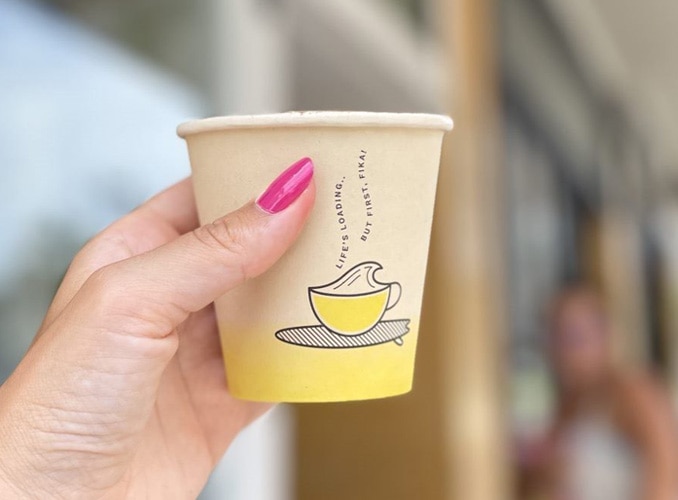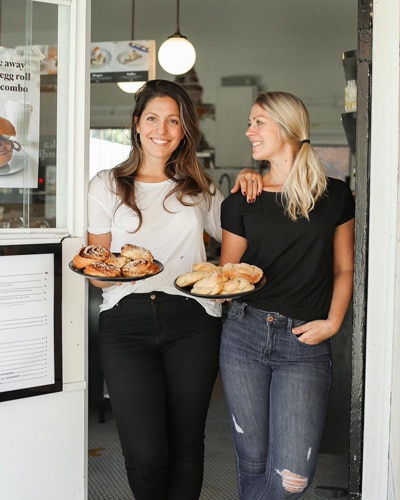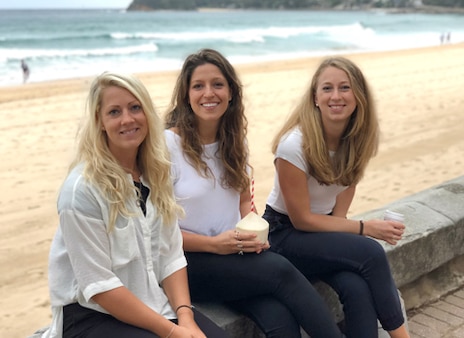This month, we spoke with Linda, one of the co-founders of Fika, to talk about the cafés and bakehouses that are bringing a little bit of Sweden to popular Sydney beaches
Welcome back to Better TLKS: A Swedish Sustainability Series. From our roots in Sweden to our over 100-year history of designing premium products that help people live better at home, this series will spotlight leaders and pioneers in the sustainability space, much like us, to uncover their sustainability journey and help inspire you to live a more considered life.
This month, we’re talking to Linda Stanes, co-founder of Fika, the café and Swedish eatery now open in two locations at Bondi and Manly Beach, in Sydney, Australia.
Linda and her co-founders, Diana and Sophie, met while travelling to Australia from Sweden over 10 years ago, and the rest was history. Here, we talk to Linda about why we should all take a ‘fika’, what being ‘green’ means to her, and what she has learnt about sustainability from her Swedish roots.
1. What was the inspiration behind fika?
The three of us – Diana, Sophie and I - met in Sydney as Swedish travellers in Australia over 10 years ago. We loved it so much that we decided to stay and started celebrating our Swedish traditions with both our Aussie and Swede friends. We needed somewhere to have a ‘fika’ with our friends, both from here and home. ‘Fika’ is the Swedish word for a coffee break – a time to stop in between meals, catch up with those you love and have a quick bite to eat over coffee.
Opening our own spot for ‘fika’ started as a joke – we said that if no one has opened up a fika soon, we’ll do it. Fast forward a few months, and we opened fika Manly in 2013. The fika cafés, now in both Manly and Bondi, are now a ‘home away from home’ for us and others to enjoy.
2. What is coming up for you in 2023?
Only last November, we opened our bakery in Manly to customers on weekends, and it absolutely took off. Now, it’s open five days a week, and we’re using it for production across both cafés.
We’ve been baking our cinnamon buns, brownies, cookies and more in-house since day one, but it wasn’t well-known by our customers, so it’s been great for those who visit fika to see us baking our own Swedish treats fresh every day. We were always a bakery, but the magic was hidden away in a kitchen. We’re also keen to start making more savoury treats in the bakery as the year rolls on, too.
3. Electrolux is a Swedish brand. What about Swedish cuisine or ways of living do you admire or feel most inspired by?
In Sweden, our ways of living and cuisine are both very seasonal and focused on very old traditions. We make certain dishes at different times of the year, in line with the ideal times to harvest different kinds of produce – whether that’s picking berries or fishing for crayfish (we even have crayfish parties at the end of summer).
The seasons and the harvests dictate how we eat through the year in Sweden, and as a result, we eat very sustainably with a lower impact on the environment. Eating seasonally also reduces our reliance on large-scale mass food production compared to other countries.
Moving to Australia was an adjustment, as most foods are always readily available and tend to be eaten throughout the year. We do see things changing, though, as Australia starts to consider sustainable approaches to agriculture.
4. Electrolux has a Better Living 2030 program that encourages people to employ more sustainable approaches to living. What are some tips you can share on living more sustainably?
Aside from the way we eat, transport in Sweden is very different, too. We have very harsh winters, but Swedes are always outdoors. From a young age, we either walk or ride our bikes to school. In Australia, there are greater distances to cover, but more people do tend to rely on their cars even to drive short distances. The way people look at commuting is different in Sweden – the impact of transport is always considered, and our public transport is very sustainable, too.
Recycling is also far more deliberate. We separate our metal, coloured glass, normal glass, cardboard and paper – all are recycled in their own way. We learn at school to wash and flatten milk cartons, and Sweden has also had container recycling programs in supermarkets for over 30 years.
Sustainable approaches to the way we eat, live and travel are ingrained in us from a young age – it’s a way of life. We spent days in the forest in school as part of our education, too, just learning about nature and how to respect it every day with our habits.
5. If there was one thing Australians could learn from Swedish habits and way of life, what would it be?
Starting sustainable habits at a young age – and all the small ways that we can each contribute to big changes. Learning sustainable habits from childhood is what helps them stick to the Swedish.
6. What is your approach to sustainability and how has it changed over the past decade?
Thankfully, growing up in Sweden, I’ve always lived very sustainably. I buy a lot of goods and clothes secondhand, minimise waste, and also try to ride my bike, walk or catch public transport each day instead of driving.
When I first arrived in Australia, life here was generally less sustainable (over 10 years ago) and it was difficult to adjust and stick to my sustainable habits in a new country that was set up a little differently. Over time though, I have managed to keep a lot of these habits going, which I’m very proud of.
7. What does living sustainably mean to you?
To me, living sustainably is to think about how the small things we do throughout each day can impact the planet. This is easier when you are taught to think this way from a young age, but can still be learned.
Whether it’s cutting that shower a little bit short, taking the time to grab a reusable coffee cup from the cupboard on the way out to work, or taking some reusable shopping and produce bags to the supermarket when it’s time to do the groceries, it all adds up.
8. How do you practice sustainability every day?
Being in the café every day, my life revolves around fika. We don’t use any plastic, our cups and takeaway cutlery are fully compostable – not paper, not plastic, but made from cornstarch. Our produce suppliers used to wrap our vegetables in plastic, and we (kindly) asked if they’d switch it up for us – so they adapted, and everything now comes in paper and boxes. We have fika ceramic and non-ceramic takeaway cups available and give a coffee discount for those who bring their own cup. A lot of cafés do that now – which we love – but when we started, it was a novel concept.
The big one is avoiding single-use plastic – we do that at fika and I do this outside of work, too, and have done so for a very long time.
9. In your industry, what are the biggest sustainability challenges?
Mass production and large-scale manufacturing are developments that we see the signs of every day – not just at fika. We need to make a huge effort, as individuals, to curb demand for certain products – whether that is single-use plastic, produce that is out of season or fossil fuels.
Finding alternatives is hard, but the alternative to that? We won’t have a future, nor will our children.
10. What sustainability successes have you had, that you would share with either other businesses in your industry or people at home?
The suppliers changing their packaging at our request was a simple thing but felt like a big win.
As customers, I think we are able to be a little more demanding than we think – as long as we’re kind about it – and it can go a long way. We see our customers calling for change every day. Recently, we started ordering corn starch cutlery instead of wood, as it’s more sustainable. That’s just one example, but we’ve made a lot of small changes at fika and love to work with our customers when more sustainable options become available.
Every small change starts with us, and they all add up.





